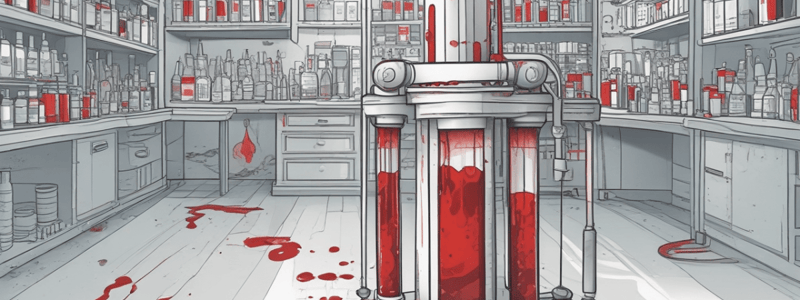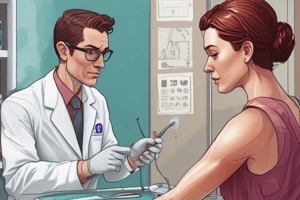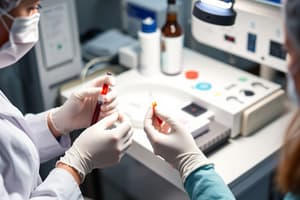Podcast
Questions and Answers
What is the correct angle for inserting the needle into the vein?
What is the correct angle for inserting the needle into the vein?
- 15° to 30° (correct)
- 15° to 45°
- 30° to 60°
- 45° to 90°
Why is it important to have the patient clench their fist?
Why is it important to have the patient clench their fist?
- To help locate the vein
- To stretch the skin downward (correct)
- To make the patient more comfortable
- To increase blood flow to the vein
What is the correct order of draw for anaerobic and aerobic blood cultures?
What is the correct order of draw for anaerobic and aerobic blood cultures?
- Anaerobic first, then aerobic (correct)
- It doesn't matter which one is first
- Aerobic first, then anaerobic
- Only collect one or the other
Why is it important to invert each tube after collection?
Why is it important to invert each tube after collection?
What is the purpose of the two-point check?
What is the purpose of the two-point check?
When should the tourniquet be removed?
When should the tourniquet be removed?
What is the correct way to dispose of the needle assembly?
What is the correct way to dispose of the needle assembly?
Why is it important to apply pressure to the puncture site?
Why is it important to apply pressure to the puncture site?
What is the final step in the blood collection procedure?
What is the final step in the blood collection procedure?
What is the purpose of stretching the skin downward below the collection site?
What is the purpose of stretching the skin downward below the collection site?
What should be done when collecting two blood cultures from the same patient?
What should be done when collecting two blood cultures from the same patient?
What is an essential step in preparing the patient's skin for blood culture collection?
What is an essential step in preparing the patient's skin for blood culture collection?
What should be done with the blood culture specimens after collection?
What should be done with the blood culture specimens after collection?
What is a critical aspect of observing standard precautions when assisting with blood cultures?
What is a critical aspect of observing standard precautions when assisting with blood cultures?
What should be done to ensure proper disposal of supplies after blood culture collection?
What should be done to ensure proper disposal of supplies after blood culture collection?
What should be documented after assisting with blood culture collection?
What should be documented after assisting with blood culture collection?
Why is it important to have two complete sets of equipment for blood culture collection?
Why is it important to have two complete sets of equipment for blood culture collection?
What should be done to ensure the patient's safety after blood culture collection?
What should be done to ensure the patient's safety after blood culture collection?
What is the purpose of having a protective pad under the patient's arm during blood culture collection?
What is the purpose of having a protective pad under the patient's arm during blood culture collection?
What should be ensured when preparing for blood culture collection?
What should be ensured when preparing for blood culture collection?
What is the primary purpose of ordering a blood culture test?
What is the primary purpose of ordering a blood culture test?
What is the minimum number of patient identifiers required to properly identify a patient before collecting a blood culture sample?
What is the minimum number of patient identifiers required to properly identify a patient before collecting a blood culture sample?
What is the purpose of washing hands and donning gloves before collecting a blood culture sample?
What is the purpose of washing hands and donning gloves before collecting a blood culture sample?
How many blood culture bottles are required per collection?
How many blood culture bottles are required per collection?
What is the purpose of applying a tourniquet during blood culture collection?
What is the purpose of applying a tourniquet during blood culture collection?
What is the recommended method for cleansing the skin before venipuncture?
What is the recommended method for cleansing the skin before venipuncture?
What should be done after cleansing the skin with 70% isopropyl alcohol?
What should be done after cleansing the skin with 70% isopropyl alcohol?
What is the purpose of reviewing the medical requisition form before collecting a blood culture sample?
What is the purpose of reviewing the medical requisition form before collecting a blood culture sample?
What happens to the blood sample after it is sent to the laboratory?
What happens to the blood sample after it is sent to the laboratory?
What is the next step if micro-organisms are found to be growing in the blood culture sample?
What is the next step if micro-organisms are found to be growing in the blood culture sample?
Antiseptic pads can be reused when collecting multiple blood cultures from the same patient.
Antiseptic pads can be reused when collecting multiple blood cultures from the same patient.
When assisting with blood cultures, it is necessary to provide gloves for the person you are assisting, but not for yourself.
When assisting with blood cultures, it is necessary to provide gloves for the person you are assisting, but not for yourself.
Only one blood culture bottle is required per collection, regardless of the type of culture.
Only one blood culture bottle is required per collection, regardless of the type of culture.
When collecting blood cultures, you should wash your hands before the procedure, but gloves are not necessary.
When collecting blood cultures, you should wash your hands before the procedure, but gloves are not necessary.
After collecting blood cultures, the specimens can be left at room temperature for several hours before being sent to the laboratory.
After collecting blood cultures, the specimens can be left at room temperature for several hours before being sent to the laboratory.
The area should be touched after it has been cleansed and allowed to dry completely.
The area should be touched after it has been cleansed and allowed to dry completely.
The needle should be inserted into the vein at a 90° angle.
The needle should be inserted into the vein at a 90° angle.
The patient should be asked to unclench their fist after the blood culture bottle is filled.
The patient should be asked to unclench their fist after the blood culture bottle is filled.
The tourniquet should be removed after 2 minutes.
The tourniquet should be removed after 2 minutes.
The needle assembly should be disposed of in a regular trash can.
The needle assembly should be disposed of in a regular trash can.
The antiseptic used to cleanse the top of the blood collection bottles is povidone-iodine.
The antiseptic used to cleanse the top of the blood collection bottles is povidone-iodine.
A blood culture requisition is typically ordered to diagnose patients with a known fever origin.
A blood culture requisition is typically ordered to diagnose patients with a known fever origin.
The tourniquet should be left on until the needle is inserted into the vein.
The tourniquet should be left on until the needle is inserted into the vein.
Only one blood culture bottle is required per collection.
Only one blood culture bottle is required per collection.
If micro-organisms are found to be growing in the blood culture sample, the test is complete and no further testing is needed.
If micro-organisms are found to be growing in the blood culture sample, the test is complete and no further testing is needed.
Flashcards are hidden until you start studying
Study Notes
Assisting with Specimen Collections
- Other health professionals may need assistance with blood culture collections, which involves notifying laboratory personnel, assembling materials, and explaining procedures to patients.
- When collecting two blood cultures from the same patient, ensure two complete sets of equipment are available, and do not reuse antiseptic pads, gauze, or needles.
Blood Culture Collection Procedure
- Obtain and label proper tubes or bottles.
- Wash hands, and put on gloves, as well as provide gloves for the person assisting.
- Place a protective pad under the patient's arm.
- Prepare the patient's skin with at least two antiseptic wipes and cleanse the area twice.
- Assist in the venipuncture process.
- Assist with applying pressure bandages to venipuncture sites upon completion.
- Check the patient a few minutes later to ensure bleeding has stopped.
- Assist with proper disposal of all supplies.
- Document the procedure, including date, time, and who performed it.
- Immediately take the specimens to the laboratory.
Blood Cultures
- Blood cultures are laboratory tests used to check for bacteria or microorganisms in a blood sample.
- They are used to diagnose conditions in patients with a fever of unknown origin (FUO).
- When processing a blood sample, it is placed into a specialized dish and observed to see if microorganisms grow.
- If growth occurs, further tests are done to identify the specific microorganisms present.
Steps to Perform a Blood Culture
- Introduce yourself and properly identify the patient using at least two patient identifiers.
- Wash hands, and put on gloves.
- Assemble supplies, including a winged infusion set or syringe needle, adapter, and blood culture collection bottles.
- Review the medical requisition form to determine how much blood needs to be collected.
- Mark blood collection bottles with the required blood level.
- Remove the protective cap, and cleanse the top of the blood collection bottles with an antiseptic.
- Apply a tourniquet and palpate to find an accessible blood vessel.
- Cleanse the area with 70% isopropyl alcohol with a friction scrub, followed by chlorhexidine gluconate or povidone-iodine.
- Allow the area to dry completely before venipuncture.
- Reapply the tourniquet after the area has dried.
- Insert the needle into the vein at a 15° to 30° angle with the bevel facing up.
- Pop the blood culture bottle onto the double-pointed needle.
- Have the patient unclench their fist as blood enters the tube or bottle.
- Gently invert the tube to mix the specimen after removal from the needle holder.
- Remove the tourniquet before 1 minute and monitor the patient's condition.
- Dispose of the needle assembly into a sharps container and apply pressure to the puncture site.
- Label all blood collection bottles and tubes before leaving the patient.
- Check the patient's status again before leaving the room or dismissing the patient.
Assisting with Specimen Collections
- Other health professionals may need assistance with blood culture collections, which involves notifying laboratory personnel, assembling materials, and explaining procedures to patients.
- When collecting two blood cultures from the same patient, ensure two complete sets of equipment are available, and do not reuse antiseptic pads, gauze, or needles.
Blood Culture Collection Procedure
- Obtain and label proper tubes or bottles.
- Wash hands, and put on gloves, as well as provide gloves for the person assisting.
- Place a protective pad under the patient's arm.
- Prepare the patient's skin with at least two antiseptic wipes and cleanse the area twice.
- Assist in the venipuncture process.
- Assist with applying pressure bandages to venipuncture sites upon completion.
- Check the patient a few minutes later to ensure bleeding has stopped.
- Assist with proper disposal of all supplies.
- Document the procedure, including date, time, and who performed it.
- Immediately take the specimens to the laboratory.
Blood Cultures
- Blood cultures are laboratory tests used to check for bacteria or microorganisms in a blood sample.
- They are used to diagnose conditions in patients with a fever of unknown origin (FUO).
- When processing a blood sample, it is placed into a specialized dish and observed to see if microorganisms grow.
- If growth occurs, further tests are done to identify the specific microorganisms present.
Steps to Perform a Blood Culture
- Introduce yourself and properly identify the patient using at least two patient identifiers.
- Wash hands, and put on gloves.
- Assemble supplies, including a winged infusion set or syringe needle, adapter, and blood culture collection bottles.
- Review the medical requisition form to determine how much blood needs to be collected.
- Mark blood collection bottles with the required blood level.
- Remove the protective cap, and cleanse the top of the blood collection bottles with an antiseptic.
- Apply a tourniquet and palpate to find an accessible blood vessel.
- Cleanse the area with 70% isopropyl alcohol with a friction scrub, followed by chlorhexidine gluconate or povidone-iodine.
- Allow the area to dry completely before venipuncture.
- Reapply the tourniquet after the area has dried.
- Insert the needle into the vein at a 15° to 30° angle with the bevel facing up.
- Pop the blood culture bottle onto the double-pointed needle.
- Have the patient unclench their fist as blood enters the tube or bottle.
- Gently invert the tube to mix the specimen after removal from the needle holder.
- Remove the tourniquet before 1 minute and monitor the patient's condition.
- Dispose of the needle assembly into a sharps container and apply pressure to the puncture site.
- Label all blood collection bottles and tubes before leaving the patient.
- Check the patient's status again before leaving the room or dismissing the patient.
Studying That Suits You
Use AI to generate personalized quizzes and flashcards to suit your learning preferences.




